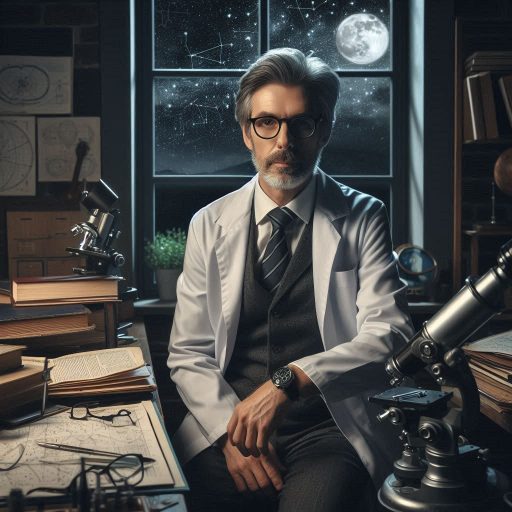Introduction
Environmental scientists are professionals who study the natural environment and help develop solutions to protect it. lets discuss on, environmental scientist typical day
They play a crucial role in preserving the Earth’s ecosystems and addressing issues like pollution, climate change, and resource management.
Studying the typical day of an environmental scientist provides valuable insights into their work and the challenges they face.
A typical day for an environmental scientist begins with conducting fieldwork to collect samples, monitor environmental conditions, and gather data.
They may visit different locations, such as forests, rivers, or industrial sites, to collect samples and assess the impact of human activities on the environment.
Back at the lab, environmental scientists analyze the collected samples using various techniques and equipment.
They study the composition and quality of soil, water, and air samples to detect pollutants, assess biodiversity, and monitor ecosystem health.
In addition to fieldwork and laboratory analysis, environmental scientists also spend a significant amount of time conducting research, writing reports, and developing strategies to mitigate environmental problems.
They collaborate with other scientists, policymakers, and communities to implement sustainable solutions.
An environmental scientist’s work is not only important for environmental preservation, but also for the well-being of communities and future generations.
By studying their typical day, we gain an understanding of the challenges they face and the impact they make in creating a sustainable future.
Essentially, environmental scientists play a vital role in studying and protecting the environment.
Studying their typical day helps us appreciate the importance of their work in preserving ecosystems and ensuring a sustainable future for all.
Morning Routine
Waking up early to start the day
After a restful night’s sleep, an environmental scientist begins their day by waking up early, ready to tackle the challenges ahead.
Reviewing previous day’s notes and tasks
Before diving into the tasks of the present day, the scientist takes a moment to review the notes and tasks from the previous day.
Preparing necessary equipment for the fieldwork
To ensure a successful day of fieldwork, the scientist carefully prepares all the necessary equipment beforehand.
As the sun begins to rise, signaling the start of a new day, an environmental scientist prepares to embrace the challenges and discoveries that lie ahead.
With a clear mind and a sense of purpose, the scientist wakes up early, ready to tackle the day’s tasks.
Before immersing themselves in the present, the scientist takes a moment to reflect and review the notes and tasks from the previous day.
This brief review acts as a reminder of the progress made and the goals that still need to be achieved.
Once the previous day’s work has been revisited and appreciated, the scientist turns their attention to the day’s main event‘fieldwork.
Fieldwork is an integral part of an environmental scientist’s job as it provides valuable real-world data and insights.
Before heading out into the field, the scientist meticulously checks and prepares all the necessary equipment and supplies.
Preparing for Environmental Fieldwork
From measuring tools to sample collection kits, every item must be accounted for and organized.
Having all the necessary equipment ready and organized ensures the scientist won’t waste any time once they reach the field.
During this preparation process, the scientist also double-checks the research objectives and protocols to ensure accuracy.
The fieldwork equipment is carefully packed into a backpack or a vehicle, depending on the nature of the research.
Transform Your Career Today
Unlock a personalized career strategy that drives real results. Get tailored advice and a roadmap designed just for you.
Start NowThe scientist’s morning routine sets the tone for the rest of the day, promoting efficiency and productivity.
By waking up early and reviewing the previous day’s notes, the scientist establishes a clear direction for the day ahead.
Being equipped with the necessary tools and supplies further enhances the scientist’s ability to gather accurate data during fieldwork.
The morning routine serves as a ritual that mentally prepares the scientist for the challenges that lie ahead.
With the morning routine completed, the scientist is now ready to embark on the exciting adventures that await in the fieldwork.
The morning routine of an environmental scientist exemplifies their commitment to their work and their dedication to the environment.
As the sun continues to rise, the scientist steps outside, filled with anticipation and a strong desire to make a positive impact.
Fieldwork Activities
Visiting various field locations
Collecting samples and data
One of the main tasks of an environmental scientist is to collect samples and data from different field locations.
This involves going out into the natural environment and gathering information related to the study at hand.
Conducting experiments and studies
Environmental scientists often conduct experiments and studies in the field to better understand the impact of certain factors on the environment.
This can involve testing soil and water samples, measuring air quality, or monitoring biodiversity.
Collaborating with team members on projects
Working as part of a team is crucial for an environmental scientist. They collaborate with other researchers, scientists, and technicians to carry out projects and achieve common goals.
This collaboration allows for a more comprehensive and diverse approach to environmental research.
Utilizing specialized tools and techniques
Environmental scientists rely on a wide range of specialized tools and techniques to carry out their fieldwork activities.
These can include equipment for collecting and analyzing samples, monitoring devices, GPS technology, and remote sensing tools. Using these tools ensures accurate data collection and analysis.
Documenting observations and findings
Accurate documentation is a vital part of an environmental scientist’s fieldwork. They need to record their observations, findings, and any significant information they gather during their activities.
This documentation helps in data analysis, report writing, and publishing research findings.
By engaging in fieldwork activities, environmental scientists gain firsthand experience and insights into the natural environment they are studying.
It allows them to directly interact with the elements they are researching, providing a deeper understanding of the complexities involved.
Fieldwork also offers opportunities for environmental scientists to contribute to conservation efforts, assess environmental impacts, and develop sustainable solutions for various challenges.
Read: Biologist‘s Toolkit: Essential Equipment and Technology in the US
Office Work
Returning to the office after fieldwork
After a tiring day in the field, an environmental scientist returns to the office to continue their work.
They remove their dirty boots and protective gear before settling down at their desk.
The scientist logs their fieldwork data into a computer database for future reference and analysis.
They review their notes and photographs, ensuring that all essential information is recorded accurately.
Any samples collected are carefully stored in the designated laboratory for further testing and analysis.
Analyzing collected data
Once the fieldwork data is logged, the scientist begins the crucial task of analyzing the collected information.
Transform Your Career Today
Unlock a personalized career strategy that drives real results. Get tailored advice and a roadmap designed just for you.
Start NowThey use specialized software and statistical tools to process and interpret the data accurately.
By analyzing the data, the scientist can identify patterns, trends, and potential environmental impacts.
They examine various parameters such as pollutant levels, biodiversity, and habitat health to derive meaningful conclusions.
It requires meticulous attention to detail and critical thinking to ensure reliable and accurate results.
Writing reports and preparing presentations
Based on their data analysis, the environmental scientist starts preparing reports and presentations.
They organize their findings, making them easily understandable for both technical and non-technical audiences.
The scientist highlights important results, provides recommendations, and suggests potential mitigation strategies.
They use visual aids such as graphs, charts, and maps to present complex data in a clear and concise manner.
It is crucial for the scientist to convey their research outcomes effectively to stakeholders and decision-makers.
Attending meetings and discussing project progress
The environmental scientist regularly attends meetings with project team members and stakeholders.
During these meetings, they discuss the progress of ongoing projects and share updates with the team.
They provide insights based on their data analysis and address any concerns or challenges faced during the process.
The scientist collaborates with colleagues, exchanging ideas and brainstorming innovative solutions.
By actively participating in meetings, they ensure efficient project management and effective communication.
Read: Work Environments: From Labs to Fields for US Biologists

Continuous Learning and Research
In order to stay at the forefront of environmental science, I dedicate a significant amount of time to continuous learning and research.
This allows me to keep up with the latest developments and contribute to the advancement of the field.
Reading scientific journals and publications
One key aspect of my daily routine involves reading scientific journals and publications.
These sources provide valuable insights into recent research findings and help me stay updated on the latest discoveries in environmental science.
By staying current with the literature, I can broaden my knowledge base and gain a deeper understanding of various environmental issues.
This knowledge enables me to approach my own research projects in a more informed and thoughtful manner.
Keeping up with latest environmental research
As an environmental scientist, it is crucial for me to remain well-informed about the latest environmental research.
This involves regularly monitoring scientific databases and online platforms where new studies and reports are published.
By keeping up with the latest research, I can incorporate new findings into my own work and ensure that my projects are relevant and impactful.
It also allows me to identify potential gaps in the existing knowledge and plan future research endeavors accordingly.
Transform Your Career Today
Unlock a personalized career strategy that drives real results. Get tailored advice and a roadmap designed just for you.
Start NowAttending conferences and workshops
Another important aspect of continuous learning and research is attending conferences and workshops.
These events provide opportunities to interact with other scientists, exchange ideas, and learn about cutting-edge research.
Conferences and workshops also offer valuable networking opportunities, allowing me to establish collaborations with other experts in the field.
By sharing knowledge and resources, we can collectively advance our understanding of environmental science and tackle complex issues more effectively.
Collaborating with other scientists and experts
Collaboration is an essential part of my work as an environmental scientist.
By actively seeking collaborations with other scientists and experts in related fields, I can tap into a diverse range of expertise and perspectives.
Collaborations enable me to conduct multidisciplinary research that addresses complex environmental problems from various angles.
By combining our skills and knowledge, we can generate innovative solutions and contribute to sustainable practices and policies.
Continuous learning and research are fundamental to the growth and development of an environmental scientist.
By staying updated with the latest scientific literature, attending conferences and workshops.
And collaborating with other experts, I can contribute to the advancement of environmental science and make a positive impact on our planet.
Read: Public Perception: The Role and Impact of Biologists in American Society
Explore Further: International Scientists in the U.S.: Visa and Career Insights
You Might Also Like: Famous Toxicologists and Their Contributions
Environmental Advocacy
A day in the life of an environmental scientist not only involves conducting research and monitoring environmental conditions, but also actively engaging in environmental advocacy.
Here are some of the ways environmental scientists contribute to raising awareness and working towards sustainability:
Participating in public awareness campaigns
- Organizing and participating in rallies, protests, and marches to advocate for environmental protection.
- Collaborating with environmental organizations to design and implement public awareness campaigns.
- Using social media platforms to spread awareness about environmental issues and share scientific findings.
- Speaking at public events and conferences to educate and engage the community in environmental conservation efforts.
- Writing articles and op-eds for newspapers and magazines to reach a wider audience and provoke discussions.
Educating the community about environmental issues
- Conducting workshops and training sessions to educate individuals on sustainable practices and conservation techniques.
- Designing educational programs for schools to teach young students about the importance of protecting the environment.
- Collaborating with museums and science centers to develop interactive exhibits that showcase environmental concepts.
- Visiting schools and universities as guest speakers to inspire students to pursue careers in environmental science.
- Engaging with local communities through town hall meetings and open forums to address their environmental concerns.
Consulting with government agencies and organizations
- Providing expert advice and recommendations to government agencies on environmental policies and regulations.
- Collaborating with environmental NGOs to develop strategies for sustainable resource management.
- Working closely with policymakers to integrate scientific research into decision-making processes.
- Participating in environmental impact assessments to evaluate potential consequences of proposed projects.
- Engaging in dialogue with industry representatives to promote sustainable practices and technologies.
Environmental scientists actively engage in public awareness campaigns, educate communities, and consult with government agencies and organizations to advocate for natural resource protection and preservation.
Their efforts contribute to the overall goal of creating a sustainable and environmentally conscious society.
Read: International Opportunities: Working as a US Biologist Abroad
Work-Life Balance
Importance of Self-Care and Mental Wellbeing
- As an environmental scientist, it is crucial to prioritize self-care and maintain mental wellbeing.
- Taking care of oneself ensures a healthy work-life balance and enhances overall productivity.
- Engaging in activities that promote relaxation and reduce stress is essential for mental health.
- Regular exercise, sufficient sleep, and a balanced diet contribute to both physical and mental wellbeing.
- Seeking support from loved ones, friends, or professionals can significantly improve mental health.
Engaging in Outdoor Activities During Free Time
- Being an environmental scientist allows for a deep appreciation and love for the outdoors.
- Taking advantage of free time to engage in outdoor activities can recharge and rejuvenate the mind.
- Hiking, camping, or simply spending time in nature helps alleviate stress and promotes a healthy state of mind.
- Exploring natural landscapes not only brings joy but also deepens the understanding of the environment.
- Outdoor activities also provide an opportunity to connect with like-minded individuals and build strong bonds.
Pursuing Personal Interests and Hobbies
- Having personal interests and hobbies outside of work is essential for a balanced and fulfilling life.
- Engaging in activities that bring joy and passion contributes to overall happiness and satisfaction.
- Pursuing creative outlets such as painting, playing an instrument, or writing can be therapeutic.
- Joining clubs, attending workshops, or participating in community events related to personal interests enriches one’s life.
- Balancing professional responsibilities with personal passions creates a sense of fulfillment and purpose.
Overall, maintaining a healthy work-life balance as an environmental scientist is crucial for personal wellbeing and professional success.
By prioritizing self-care, engaging in outdoor activities, and pursuing personal interests, individuals can lead a fulfilling and meaningful life.
Remember to cherish moments of relaxation and prioritize mental wellbeing as you navigate the demands of your career.
Discover More: What Does an Archaeologist Do? A Day in the Life
Conclusion
A day in the life of an environmental scientist is diverse and rewarding. From field research to laboratory analysis, their work is crucial in understanding and protecting our environment.
Throughout the day, environmental scientists engage in data collection, hypothesis testing, and problem-solving to address various environmental issues.
Their efforts contribute to the preservation of ecosystems and the sustainability of natural resources.
By emphasizing the significance of their work, we recognize the importance of environmental scientists in creating a healthier and more sustainable world for future generations.
If you are interested in making a difference in the environment, pursuing a career in environmental science may be the path for you.
This field offers a wide range of opportunities for those passionate about sustainability, conservation, and scientific exploration.
Whether it be studying climate change, researching pollution solutions, or managing wildlife habitats, environmental science career paths offer unique and impactful ways to contribute to the betterment of our planet.
So, if you feel inspired by the day in the life of an environmental scientist, take the leap and explore the possibilities awaiting you in this field.
Together, we can make a lasting difference in protecting and preserving our planet for future generations.




